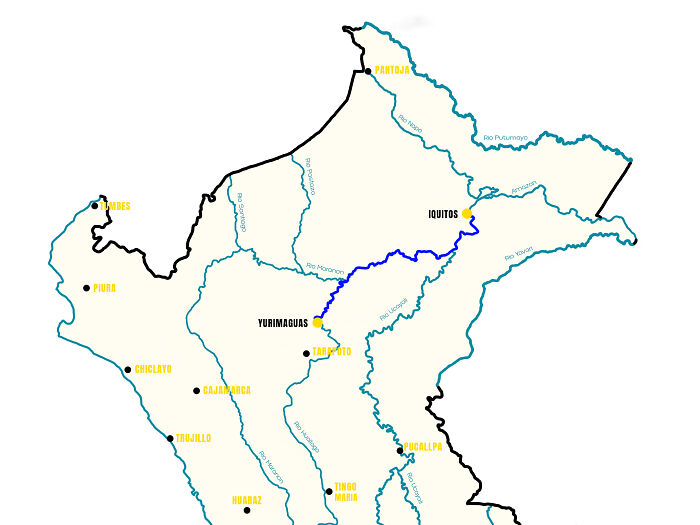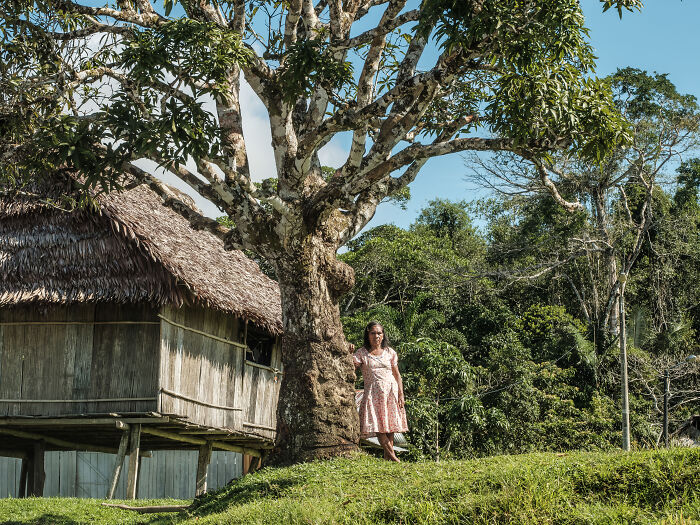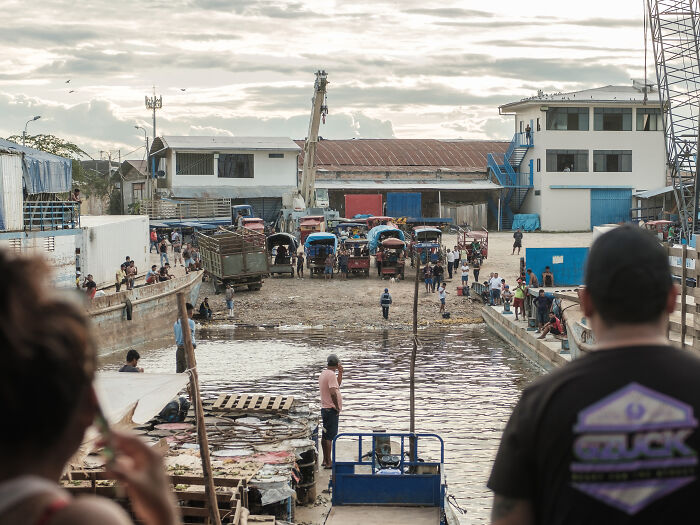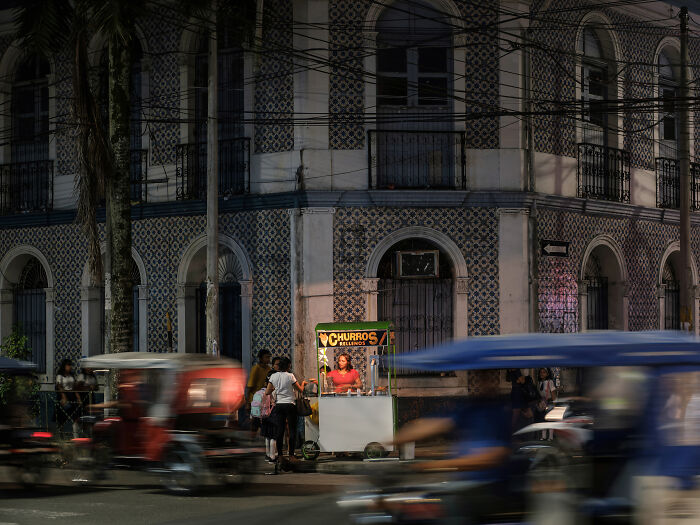
For 3 Days I Traveled On A Cargo Ship To Reach The Largest City In The World Inaccessible By Road
Yurimaguas is the city where the road ends – from here on, all the traveling is done by boat. Located in northern Peru, in the Loreto Region, Yurimaguas is the gateway to the Amazon River and the last town connected by road to the rest of the country. As you venture into this remote corner of the world, your journey starts at La Boca port in Yurimaguas. This bustling riverfront hub is a hive of activity, with cargo boats of all sizes loading and unloading goods bound for distant Amazonian communities. It’s a place where the rhythm of life is dictated by the ebb and flow of the river.
More info: Instagram | juodele.com | behance.net | Etsy
Here is the map of Northern Peru
The Peruvian Amazon has been calling me for a long time. I have always wanted to experience the real Amazonian jungle and the might of the longest river in the world. However, commercial tours, expeditions, and jungle retreats never fascinated me as I wanted to have a direct and personal experience. So as soon as I found out that there are cargo boats shuttling up and down the river, offering a slow and intimate Amazon river experience when sharing the deck with the locals, I knew that was exactly what I was looking for.
La Boca Port, Yurimaguas
Moto taxis in La Boca port, Yurimaguas
Eduardo 7 departs on a journey from Yurimaguas to Iquitos
The journey from Yurimaguas to Iquitos, a major city deep in the heart of the Amazon, is the best thing I did during my three months in Peru. If you are planning on going to Iquitos, which you should, don’t deprive yourself of the pleasure of spending three days on a cargo boat loaded with pigs and chickens and slowly cruising along the Amazonian waterways and getting a glimpse of life in remote Amazonian villages. The cargo boats, though not luxurious by any means, offer an authentic experience of river travel. You’ll share deck space with locals and possibly fellow travelers, and the days will be filled with the mesmerizing sights and sounds of the Amazon rainforest.
The skipper of Eduardo 7 navigates his way out of La Boca port
Passengers rest in hammocks on the Eduardo 7
The most memorable experience of the trip was sitting on the nose of the ship with two fellow travelers with our feet dangling down almost touching the water as the boat was gliding through the sunset-lit Amazon river and sharing a bottle of wine we bought previously in one of the jungle communities.
Men offload plastic cages with chickens in them, Maipuco
Moto taxi and its passengers in Maipuco
Lonely boat in the Amazon river
Passengers of Eduardo 7
Cargo boats are the lifeline for the communities along the river, and they also provide a unique travel experience. They depart regularly from La Boca port at the intervals of a few days, the departure date solely depends on how quickly the boat is loaded with goods and cattle, and that always takes longer than expected. Our boat – Eduardo 7 – was bound to leave at 5.30 pm on Saturday. However, we were told that realistically it wouldn’t leave until 7 am on Sunday. Finally, we ended up leaving at 2.30 pm.
Street life in San Jose De Saramuro
The way I photograph is very non-intrusive. I strive to impact the situation as little as possible with my presence. I seek to portray sensitive moments of human connection and convey the human soul at its purest.
Peaceful day traveling on the Amazon
Another cargo boat
A woman stands on the shore of the Amazon River
Another cargo boat traveling in the opposite direction
The man with his rooster
Chambira
Eduardo 7 took 52 hours to complete the 700-kilometre journey through the rivers of Huallaga, Marañon, and Amazon, which are all part of the Amazon river basin that covers more than 6,000,000 square kilometers. Along the way, multiple stops are made at small villages and communities to pick up and drop off passengers, offload cargo, or deliver packages to people. Several of those stops were long enough to disembark and spend a few minutes on land having a glimpse of life in the Amazon villages that depend solely on these kinds of boats for their survival. Some of those villages were large enough to even have a couple of streets and shops selling some basic food products, snacks, and even wine!
Villagers pick up their share of chickens from Eduardo 7, San Roque
The man with his hens, San Roque
A small community on the shore of the Amazon River
Pigs travel aboard Eduardo 7
The small boat regularly inspects the waters ahead of Eduardo 7 to make sure the river is deep enough for the cargo ship
Chickens travel on the top floor of Eduardo 7
Early morning mist and wooden boats on the shore of the Amazon River
Early morning mist and aquatic plants in the Amazon River
Passengers of Eduardo 7
Men observe the passing cargo ship
Eduardo 7 boat makes a short stop in Tamshiyacu
Men carry plastic cages with chickens in them, Tamshiyacu
Eduardo 7 near Tamshiyacu
Bananas are being offloaded on a smaller boat as we approach the port of Iquitos
Moto taxis and trucks wait to pick up the passengers and cargo as our boat arrives at the port of Iquitos
Iquitos
Finally, your journey will lead you to Iquitos, which is situated in the heart of the Amazon rainforest in Peru. Iquitos is the largest city in the world inaccessible by road. The city holds immense historical significance as the epicenter of the rubber boom during the 19th and 20th centuries. This remote city became a symbol of the rubber trade’s economic boom, drawing adventurers and entrepreneurs from around the world. Rubber extracted from the vast rainforests surrounding Iquitos fuelled industries worldwide. The city’s prosperity led to the construction of opulent buildings and infrastructure, but it also witnessed harsh labor conditions and ecological devastation. The rubber boom’s eventual decline brought economic challenges to Iquitos, but its legacy endures as a reminder of the complex and often destructive consequences of resource exploitation in the Amazon.
The Belén district is a floating community on the Amazon River characterized by its stilted houses, bustling markets, and vibrant street life, Iquitos
The district of Belen, Iquitos
Iquitos is known as the world’s largest city inaccessible by road. The city relies on river transportation for goods and commerce. River trade is the lifeblood of Iquitos, connecting the city to the surrounding villages and the global market. The city feels like it’s an island of civilization surrounded by inaccessible jungle; big parts of the city, such as the Belén district, are floating on the water. Belén is a bustling hub of commerce where people from various cultures come together. Indigenous tribes, such as the Bora and Yagua, bring their handmade crafts, traditional medicines, and exotic fruits to sell. Tourists and traders from around the world flock to this market to experience the vibrant tapestry of the Amazonian culture. The Belén Market reflects the fusion of commerce and indigenous traditions in Iquitos.
Street seller washes limes in Belen market, Iquitos
Churros (local sweet snack) stand in Iquitos
The Yurimaguas – Iquitos trip was so mesmerizing I am already making future plans to one day to raise money for my dream project of crossing the whole length of the Amazon River from its source in Peru to its mouth in Brazil. Just like on this trip, I would love to do it all by cargo boats, taking time to stop in various communities along the way and focus more on photographing the people who live and depend on the river Amazon.
Moto taxis and vintage busses in Iquitos
Iquitos is a city bordered by the jungle on one side and by the Amazon River on the other
As my journey comes to an end in Iquitos, the heart of the Amazon rainforest in Peru, it’s worth noting that the adventure doesn’t have to stop here. The Amazon River continues its majestic course, offering opportunities for travelers to delve deeper into its secrets. From Iquitos, you can extend your voyage further into the vast Amazon basin, crossing borders into Ecuador or Brazil, where new chapters of exploration await.
12Kviews
Share on FacebookExplore more of these tags
This is a really cool trip. Great pictures too. I've always wanted to travel by boat on the Amazon but I heard mixed reports about it. Some travellers find it slow and boring. Apparently, it's the case on some stretched in Brazil where there are no communities along the way for days.
This is a really cool trip. Great pictures too. I've always wanted to travel by boat on the Amazon but I heard mixed reports about it. Some travellers find it slow and boring. Apparently, it's the case on some stretched in Brazil where there are no communities along the way for days.

 Dark Mode
Dark Mode 

 No fees, cancel anytime
No fees, cancel anytime 


























































































79
8